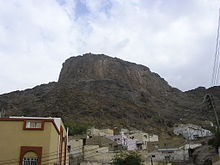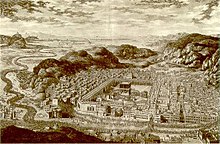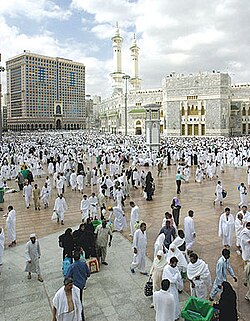Early history
Ptolemy may have called the city "Macoraba", though this identification is controversial.
Archaeology found no inscriptions or mentionings of Mecca from before that time, although other cities and kingdoms in that region are well documented in historical records.
Around the 5th century CE, the Kaaba was a place of worship for the deities of
Arabia's pagan tribes. Mecca's most important
pagan deity was
Hubal, which had been placed there by the ruling
Quraysh tribe
and remained until the 7th century CE.
In the 5th century, the Quraysh took control of Mecca, and became skilled merchants and traders. In the 6th century they joined the lucrative
spice trade as well, since battles in other parts of the world were causing
trade routes to divert from the dangerous sea routes to the more secure overland routes. The
Byzantine Empire had previously controlled the
Red Sea, but
piracy had been on the increase. Another previous route, that from the
Persian Gulf via the
Tigris and
Euphrates rivers, was also being threatened by exploitation from the
Sassanid Empire, as well as being disrupted by the
Lakhmids, the
Ghassanids, and the
Roman–Persian Wars. Mecca's prominence as a trading center surpassed the cities of
Petra and
Palmyra.

1787 Turkish artwork of the Masjid al-Haram and related religious sites (Jabal al-Nour)
By the middle of the 6th century, there were three major settlements in northern
Arabia, all along the south-western coast that borders the Red Sea, in a habitable region between the sea and the great desert to the east. This area, known as the Hejaz, featured three settlements grown around
oases, where water was available. In the center of the Hijaz was Yathrib, later renamed
Medina, from "Madinatun Nabi," or "City of the Prophet." 250 mi (400 km) south of Yathrib was the mountain city
Ta’if, north-west of which lay Mecca. Although the area around Mecca was completely barren, it was the wealthiest of the three settlements with abundant water via the renowned
Zamzam Well and a position at the crossroads of major
caravan routes.
The harsh conditions and terrain of the Arabian peninsula meant a near-constant state of
conflict between the
local tribes, but once a year they would declare a truce and converge upon Mecca in an annual pilgrimage. Up to the 7th century, this journey was intended for religious reasons by the pagan Arabs to pay homage to their shrine, and to drink from the Zamzam Well. However, it was also the time each year that disputes would be arbitrated, debts would be resolved, and trading would occur at Meccan fairs. These annual events gave the tribes a sense of common identity and made Mecca an important focus for the peninsula.
Camel caravans, said to have first been used by Muhammad's great-grandfather, were a major part of Mecca's bustling economy. Alliances were struck between the merchants in Mecca and the local nomadic tribes, who would bring goods – leather, livestock, and metals mined in the local mountains – to Mecca to be loaded on the caravans and carried to cities in
Syria and
Iraq.
Historical accounts also provide some indication that goods from other continents may also have flowed through Mecca. Goods from
Africa and the
Far East passed through on route to Syria including spices, leather, medicine, cloth, and slaves; in return Mecca received money, weapons, cereals and wine, which in turn were distributed throughout Arabia. The Meccans signed treaties with both the Byzantines and the
Bedouins, and negotiated safe passages for caravans, giving them water and pasture rights. Mecca became the center of a loose confederation of client tribes, which included those of the
Banu Tamim. Other regional powers such as the
Abyssinian, Ghassan, and Lakhm were in decline leaving Meccan trade to be the primary binding force in Arabia in the late 6th century.
Tradition
According to Islamic tradition, the history of Mecca goes back to
Abraham (
Ibrahim) who built the Kaaba with the help of his elder son Ishmael in around 2000 BCE when the inhabitants of what was then known as
Bakkah had fallen away from the original
monotheism of Abraham through the influence of the
Amelkites.
However, outside of Islamic tradition, little is known about the Kaaba before the 5th century CE.
Muhammad
Muhammad was born in Mecca in 570, and thus Islam has been inextricably linked with the city ever since. He was born in a minor faction, the Hashemites, of the ruling Quraysh tribe. It was in Mecca, in the nearby mountain cave of
Hira on
Jabal al-Nour, that, according to Islamic tradition, Muhammad is said to have begun receiving divine
revelations from God through the Archangel Gabriel in 610 AD, and began to preach his form of
Abrahamic monotheism against Meccan paganism. After enduring persecution from the pagan tribes for 13 years, Muhammad emigrated (see
Hijra) in 622 with his companions, the
Muhajirun, to Yathrib (later called Medina). The conflict between the Quraysh and the Muslims, however, continued: the two fought in the
Battle of Badr, where the Muslims defeated the Quraysh army outside Medina; while the
Battle of Uhud ended indecisively. Overall, however, Meccan efforts to annihilate Islam failed and proved to be very costly and ultimately unsuccessful. During the
Battle of the Trench in 627, the combined armies of Arabia were unable to defeat Muhammad's forces .
In 628, Muhammad and his followers marched to Mecca, attempting to enter the city for pilgrimage. Instead, however, they were blocked by the Quraysh, after which both Muslims and Meccans entered into the
Treaty of Hudaybiyyah, whereby the Quraysh promised to cease fighting Muslims and promised that Muslims would be allowed into the city to perform the pilgrimage the following year. Two years later, the Quraysh violated the truce by slaughtering a group of Muslims and their allies. Muhammad and his companions, now 10,000 strong, decided to march into Mecca. However, instead of continuing their fight, the city of Mecca surrendered to Muhammad and his followers who declared peace and amnesty for the inhabitants. The native pagan imagery was destroyed by Muhammad and his followers and the location
Islamized and rededicated to the worship of God. Muhammad declared Mecca as the
holiest site in Islam ordaining it as the center of Muslim pilgrimage, one of the faith's
Five Pillars. He also declared that no
non-Muslim would be allowed inside the city so as to protect it from the influence of polytheism and similar practices. Then, Muhammad returned to Medina, after assigning
Akib ibn Usaid as governor of the city. His other activities in Arabia led to the unification of the peninsula.
Muhammad died in 632, but with the sense of unity that he had passed on to his
Ummah (Islamic nation), Islam began a rapid expansion, and within the next few hundred years stretched from
North Africa well into
Asia and parts of
Europe. As the
Islamic Empire grew, Mecca continued to attract pilgrims not just from Arabia, but now from all across the
Muslim world and beyond, as Muslims came to perform the annual Hajj pilgrimage.
Mecca also attracted a year-round population of scholars, pious Muslims who wished to live close to the Kaaba, and local inhabitants who served the pilgrims. Due to the difficulty and expense of the Hajj, pilgrims arrived by boat at Jeddah, and came overland, or joined the annual caravans from Syria or Iraq.
Medieval and pre-modern times
Mecca was never capital of any of the
Islamic states but Muslim rulers did contribute to its upkeep. During the reigns of
Umar (634-44 CE) and
Uthman ibn Affan (644–56) concerns of flooding caused the caliphs to bring in
Christian engineers to build barrages in the low-lying quarters and construct dykes and embankments to protect the area round the Kaaba.
muhammad's migration to Medina shifted the focus away from Mecca, this focus moved still more when Ali, the fourth caliph took power choosing
Kufa as his capital. The
Abbasid Caliphate moved the capital to
Baghdad, in modern-day Iraq, which remained the center of the Islamic Empire for nearly 500 years. Mecca re-entered Islamic political history briefly when it was held by
Abd Allah ibn al-Zubayr, an early Muslim who opposed the Umayyad
caliphs and again when the caliph
Yazid I besieged Mecca in 683.
For some time thereafter the city figured little in politics remaining a city of devotion and scholarship governed by the Hashemite
Sharifs.
In 930, Mecca was attacked and sacked by
Qarmatians, a
millenarian Ismaili Muslim sect led by
Abū-Tāhir Al-Jannābī and centered in eastern Arabia.
The
Black Death pandemic hit Mecca in 1349.
In 1517, the Sharif, Barakat bin Muhammed, acknowledged the supremacy of the
Ottoman Caliph but retained a great degree of local autonomy.
In 1803 the city was captured by the
First Saudi State,
which held Mecca until 1813. This was a massive blow to the prestige of the (Turkish) Ottoman Empire, which had exercised sovereignty over the holy city since 1517. The Ottomans assigned the task of bringing Mecca back under Ottoman control to their powerful
Khedive (viceroy) of Egypt,
Muhammad Ali Pasha. Muhammad Ali Pasha successfully returned Mecca to Ottoman control
in 1813.
In 1818, followers of the
Salafi juristic school were again defeated, but some of the Al Saud clan survived and founded the
Second Saudi State that lasted until 1891 and lead on to the present country of Saudi Arabia.
Mecca was regularly afflicted with
cholera epidemics.
27 epidemics were recorded during pilgrimages from the 1831 to 1930. More than 20,000 pilgrims died of cholera during the 1907–08 hajj.
Revolt of Sharif e Mecca
In World War I, the Ottoman Empire was at war with Britain and its allies, having sided with Germany. It had successfully repulsed an attack on Istanbul in the
Gallipoli Campaign and on Baghdad in the
Siege of Kut. The British agent
T E Lawrence conspired with the Ottoman governor Syed Hussain bin Ali Sharif e Mecca. The Sharif of Mecca,
Hussein bin Ali revolted against the Ottoman Empire from Mecca, and it was the first city captured by his forces in the
Battle of Mecca (1916). Sharif's revolt proved a turning point of the war on the eastern front. Sharif Hussein declared a new state, the
Kingdom of Hejaz, and declared Mecca as the capital of the new kingdom.
Saudi Arabia
Following the
Battle of Mecca (1924), the Sharif of Mecca was overthrown by the Saud family, and Mecca was incorporated into Saudi Arabia.
Under Saudi rule, much of the historic city has been demolished as a result of construction programs -
see below.
On November 20, 1979 two hundred armed
Islamist dissidents led by Saudi preacher
Juhayman al-Otaibi seized the Grand Mosque. They claimed that the Saudi royal family no longer represented pure Islam and that the
Masjid al-Haram (The Sacred Mosque) and the Kaaba, must be held by those of true faith. The rebels seized tens of thousands of pilgrims as hostages and barricaded themselves in the
mosque. The siege lasted two weeks, and resulted in several hundred deaths and significant damage to the shrine, especially the
Safa-Marwa gallery.
Pakistani forces carried out the final assault; they were assisted with weapons, logistics and planning by an elite team of French commandos from
The French GIGN commando unit.












